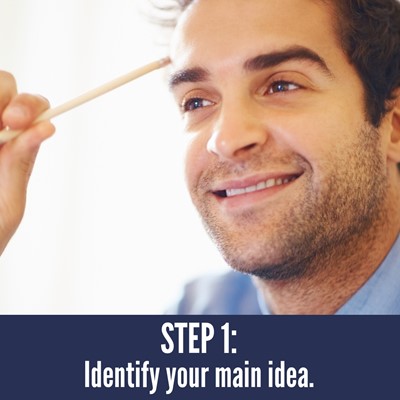
One of the most common—and most uninspiring—ways to open a presentation isn’t exactly wrong:
"I’m here today to talk to you about…"
You are, in fact, there. It is “today.” And you are talking about something.
But that statement isn’t going to hook your audience. (Well, maybe it could if you finished it with “how you’ll all be going home with one million in cash.”)
To be a better-than-average speaker, you need a strong open.
That doesn’t mean you have to ride a motorcycle onto the stage or set off fireworks. A strong open, one that grabs the audience, does two things:
1) Your open lets them know what you’re talking about.
2) Your open makes it clear why they, the audience, will care.
Public speaking, as we like to say, is a minor art form. There’s an art to how you accomplish that mission—but there are also some concrete steps to help you find your way.

Step 1: Identify your main idea
Sounds obvious, of course, but many speakers don’t seem to identify the main idea until the end of the presentation. Some speakers aren’t even sure of their main idea until they’ve put an entire presentation together. Some seem to never quite grasp it at all.
To make it clear to you and others, it helps to ask yourself: What is the one thing I want the audience to be able to say about my presentation when they walk away? Often, that’s your main idea.

Step 2: Think about your audience’s perspective
How similar are your audience members? Can you identify a common point of view they might share? What might they care about? What motivates them?
We often ask students in our public speaking courses: Who is your audience? And quite often we hear back: Everyone.
That might be true—but usually we can narrow it a bit.
Are they older or younger? Have lots of knowledge of your topic or only a little? Executives or assembly line workers? Likely to agree with you or not so much? More likely to be sports fans or do they prefer to spend their money going to the opera?
When you think about who is in your audience, their level of knowledge, and their preferences, you can get closer to Step 3.

Step 3: Determine how your audience can be connected to your main idea
Let’s imagine your main idea is this: Our company produces chemicals that are vital for growing plants around the world.
If your audience includes golfers, you might be able to connect your message to their interests by relating it to a golf course. If they’re a group of chefs, then food. If they’re chemists, you might take a scientific route. If they’re company executives, you could connect with them through the potential market for the chemicals you produce.
The goal here is to go beyond why you care and think about what they know and why they will care about the information you have for them.
Many speakers spend too much time talking about their own passion for a subject. It’s part of the curse of knowledge we all bear as speakers. Many of us forget that the audience may not automatically share our passion.
We also hear from senior executives that employees take too long to get to the point—and provide too much background. That’s why you need to think about your audience’s level of knowledge and their priorities.

Step 4: Find a way to phrase your open so it’s clear to your audience why it matters to them
We’ve heard a high school chemistry teacher describe this as an on-ramp: You’re starting with something your audience gets and using that to link them to your topic.
We think of it as appealing to their self-interest, too. Most audiences we encounter want to know "What does this have to do with me? What’s in this for me?"
The Art of the Strong Open
Once you’ve put yourself through this thought process, it’s time to dabble in the art of your strong open. How should you say it? Here are just a few options you can try:
- Be direct: State the main idea of your talk and explain why it matters to the audience.
- Be creative: Tell a story or describe a scene to make your main idea clear and illustrate why it matters to the audience.
- Go for drama: Use a powerful fact or serious problem to set up your theme.
- Draw them in: Ask them a question to set up your theme and connect it to why they care.
The best approach for your strong open depends on the topic, the tone, the audience, and to some degree, your personal speaking style.
Whatever way you choose, if you’ll challenge yourself to do better than "I’m here today to talk about…" you’ll be steps ahead of the average speaker and in a position to grab audience attention from the start.






